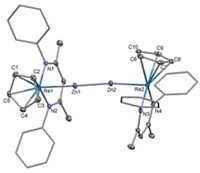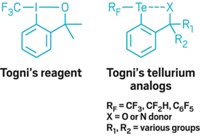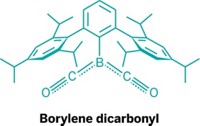Advertisement
Grab your lab coat. Let's get started
Welcome!
Welcome!
Create an account below to get 6 C&EN articles per month, receive newsletters and more - all free.
It seems this is your first time logging in online. Please enter the following information to continue.
As an ACS member you automatically get access to this site. All we need is few more details to create your reading experience.
Not you? Sign in with a different account.
Not you? Sign in with a different account.
ERROR 1
ERROR 1
ERROR 2
ERROR 2
ERROR 2
ERROR 2
ERROR 2
Password and Confirm password must match.
If you have an ACS member number, please enter it here so we can link this account to your membership. (optional)
ERROR 2
ACS values your privacy. By submitting your information, you are gaining access to C&EN and subscribing to our weekly newsletter. We use the information you provide to make your reading experience better, and we will never sell your data to third party members.
Synthesis
Nitrogen Lewis acids unveiled
Chemists find a bonding situation in which nitrogen serves as an electron acceptor, rather than an electron donor
by Stephen K. Ritter
March 13, 2017
| A version of this story appeared in
Volume 95, Issue 11
Lewis acids and bases are one of chemistry’s fundamental concepts, depicting a molecule’s ability to accept an electron pair from a partner molecule or to donate an electron pair to a partner, respectively. For example, electron-rich nitrogen-centered molecules such as ammonia function as Lewis bases. Mark Gandelman of Technion—Israel Institute of Technology and his group have found a situation in which they can turn that donor-acceptor reactivity around, so that a nitrogen-centered molecule functions as a Lewis acid (J. Am. Chem. Soc. 2017, DOI: 10.1021/jacs.6b12360). Gandelman’s group had previously studied a triazolium salt and found it to be an analog of imidazole-based N-heterocyclic carbenes, including the ability to serve as a ligand for transition metals. The central nitrogen of the saturated N–N–N triazolium unit in the molecule can accept electron density from a metal into a vacant p orbital, even though it weakly donates its lone pair of electrons residing in an sp2-type orbital to the metal. With that information in hand, the team decided to treat various triazolium compounds with different Lewis bases such as phosphides, phosphines, and carbanions and found that the nitrogen-centered molecules functioned as the Lewis acid partner. Gandelman and coworkers think these new nitrogen-based Lewis acids could join other well-established Lewis acids based on boron, phosphorus, aluminum, and tin and serve in reactive frustrated Lewis pairs or other types of catalysts.





Join the conversation
Contact the reporter
Submit a Letter to the Editor for publication
Engage with us on Twitter